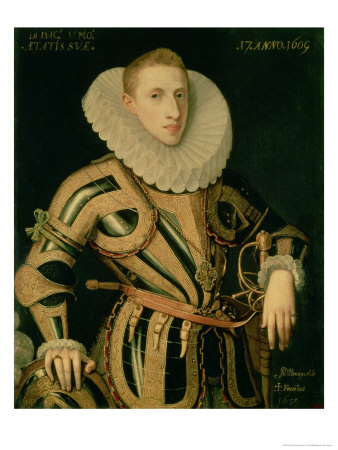 The Spanish began a long period of struggle against an enemy that had never encountered before :the Apache and the Comanche. The Spanish empire was one of extermination as regards their dealings with indigenous people but when they arrived in Texas they met people who'd fight back and with a vengeance.The Catholics actually thought they were saving people by putting them to the flame.Below Reamsa painted by myself and on sale
The Spanish began a long period of struggle against an enemy that had never encountered before :the Apache and the Comanche. The Spanish empire was one of extermination as regards their dealings with indigenous people but when they arrived in Texas they met people who'd fight back and with a vengeance.The Catholics actually thought they were saving people by putting them to the flame.Below Reamsa painted by myself and on sale They actually thought that as a person was twisting & writhing in pain they were not only experiencing the pain Christ felt while on the cross but they would also come to accept Christ as their savior, therefore by torturing thousands to death they were saving souls – - – souls that could now enter Heaven instead of being consigned to eternal Hell.
They actually thought that as a person was twisting & writhing in pain they were not only experiencing the pain Christ felt while on the cross but they would also come to accept Christ as their savior, therefore by torturing thousands to death they were saving souls – - – souls that could now enter Heaven instead of being consigned to eternal Hell. reamsa painted by myself
reamsa painted by myselfSuffer Now and be blessed for all eternity.Some say that from the beginning of Spain's rise to power right up until its twilight time millions of people were massacred.Incas, Atztecs and Muslims plus Jews.
 reamsa
reamsaSOLDADOS DE PLASTICO BLOG FOR A LOT OF THE REAMSA HERE. 
…In the public imagination, the Spanish Inquisition continues as a proverbial example of religious persecution. Some scholars however have opined that the numbers of the Spanish Inquisition’s victims may have been exaggerated, that the Inquisition is one of the features of a Black Legend (see link in sources). Most of the people who say these are Catholics.
Also, some argue that the Spanish Inquisition was responsible in part for averting in Spain the kind of religious wars that plagued France and Germany.Most of these are Catholics, I imagine.belopw Reamsa Spanish Knight

Similar arguments are made about averting witch trials in Spain. Whereas tens of thousands of women were executed for witchcraft throughout northern Europe, less than 60 (only 6 documented cases) were executed in Spain throughout the whole period of the Inquisition.” Any person who writes as an “expert” (myself included)and seeks to water down this terrible history of the Popes and the Catholic Church needs to reflect in the deepest parts of their souls whether they are doing “Gods work” in falsifying history, or deliberately or unwittingly supporting evil by their actions.below Reamsa

SOLDADOS DE PLASTICO BLOG FOR A LOT OF THE REAMSA HERE.
For when people claiming to be good people of faith begin to spin and apologise for evil, even hide evil acts, they cross the line.Does this history reflect on good Catholics today? Yes it does. Are they to blame in anyway.Not directly but indirectly. It is only those who deliberately spin, twist and disinform that must pray for the forgiveness of God for their evil actions on this subject.If you are part of a team then however good you are you are still playing for that team and if the team is evil you are part of it.This is the same as the good soldier fighting for evils like Tony Blair or the new fellow they have now (or is it two).History does not reflect upon how the Spanish were more or less totally outmanouvered by the Apache and the Comanche in what I will call Apache Land (Texas, Arizona, New Mexico etc etc)but it should for it was the first time that the insidious self self serving Spanish army and empire was defeated by tribal people.
In the end the Spanish more or less had to confine themselves to presidios and missions, fortified ones. Things got worse for the Spanish when the Apache and the Comanche started to use horses.The fact that the Spanish couldn't control the finest light cavalry in the world speaks volumes about the invention of the Colt. In my opinion this was the turning point of the wars against the Real Americans.The United States Cavalry also played a big psart in the suppression of the Real americans . It was a dirty war buit the men who fought it were for real.RThe arm of the cavalry was the Sh.arps and the Springfield

SOLDADOS DE PLASTICO BLOG FOR A LOT OF THE REAMSA HERE.
It might be that millions of people were killed by the spanish empire for the glory of the Catholic church but here in apache land they met their match.

reamsa
check out
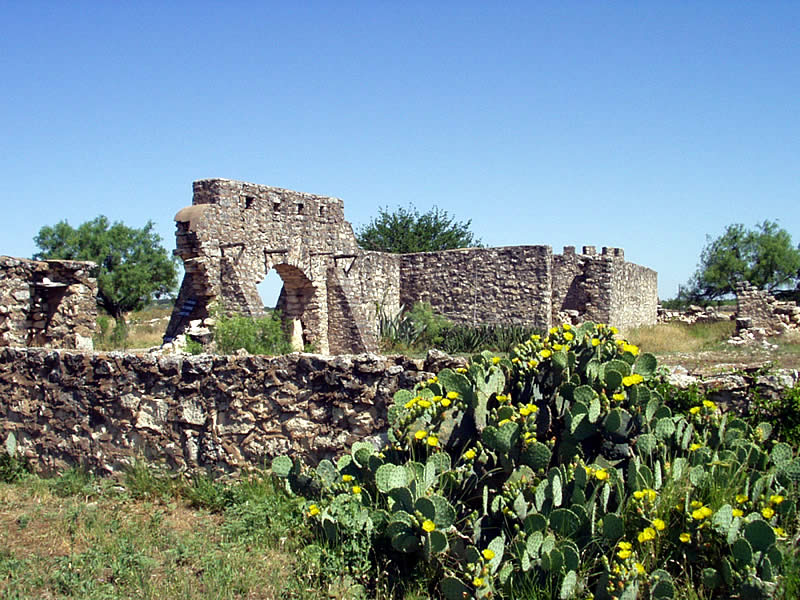
The mission San Saba in Texas.
Just a year after being established on the banks of the San Saba River in 1757, Mission Santa Cruz de San Sabá was attacked by a force of 2,000 Comanche Indians and their allies.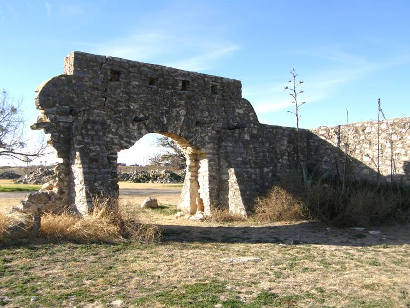

The mission of the Mission had been to convert resident Lipan Apaches to Christianity. Initially, six men were killed here, including two Franciscan Priests.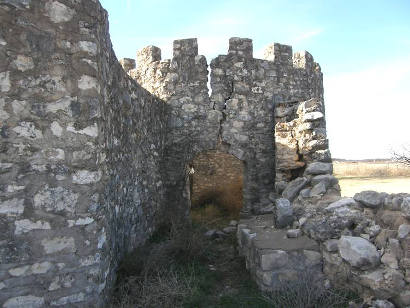 The commander of the mission’s protecting fort, the Presidio San Luis de las Amarillas, attempted to mount a campaign against the Indian force, but was defeated. The incident curtailed further Spanish expansion in Texas.
The commander of the mission’s protecting fort, the Presidio San Luis de las Amarillas, attempted to mount a campaign against the Indian force, but was defeated. The incident curtailed further Spanish expansion in Texas.
 The commander of the mission’s protecting fort, the Presidio San Luis de las Amarillas, attempted to mount a campaign against the Indian force, but was defeated. The incident curtailed further Spanish expansion in Texas.
The commander of the mission’s protecting fort, the Presidio San Luis de las Amarillas, attempted to mount a campaign against the Indian force, but was defeated. The incident curtailed further Spanish expansion in Texas.
In 1758, however, a tragic scene occurred at the San Saba mission.  The Indians, in large numbers, assaulted the mission, took it, and killed all, both pastors and flock, including the small guard stationed there. Tradition informs us that none were left to bear the news of the dreadful massacre. This mission had been established far beyond the then Texan frontier.below soldados di plastico blog photo. In my model above I have replaced the plastic spear with a shorter metal one.
The Indians, in large numbers, assaulted the mission, took it, and killed all, both pastors and flock, including the small guard stationed there. Tradition informs us that none were left to bear the news of the dreadful massacre. This mission had been established far beyond the then Texan frontier.below soldados di plastico blog photo. In my model above I have replaced the plastic spear with a shorter metal one. One of the devout said"We have seen its benevolent object. Such a return for such love, while it calls down blessings upon the heads of the devoted followers of the cross. " below Reamsa Apache
One of the devout said"We have seen its benevolent object. Such a return for such love, while it calls down blessings upon the heads of the devoted followers of the cross. " below Reamsa Apache
 The Indians, in large numbers, assaulted the mission, took it, and killed all, both pastors and flock, including the small guard stationed there. Tradition informs us that none were left to bear the news of the dreadful massacre. This mission had been established far beyond the then Texan frontier.below soldados di plastico blog photo. In my model above I have replaced the plastic spear with a shorter metal one.
The Indians, in large numbers, assaulted the mission, took it, and killed all, both pastors and flock, including the small guard stationed there. Tradition informs us that none were left to bear the news of the dreadful massacre. This mission had been established far beyond the then Texan frontier.below soldados di plastico blog photo. In my model above I have replaced the plastic spear with a shorter metal one. One of the devout said"We have seen its benevolent object. Such a return for such love, while it calls down blessings upon the heads of the devoted followers of the cross. " below Reamsa Apache
One of the devout said"We have seen its benevolent object. Such a return for such love, while it calls down blessings upon the heads of the devoted followers of the cross. " below Reamsa Apache
This fearful butchery had its effect in causing the missions in Texas to decline. In fact, they never recovered from the blow.The Comanches had done the right thing for in all other cases where Europeans were welcomed they ended up robbing the Indigenous people of their land and even their identity.All Reamsa painted by me and onslae painted)

Efforts were made to avenge this cruel outrage. Captain Don Diego Ortiz de Parilla was dispatched with a body of troops to chastise the ruthless savages; but the latter fled to their strongholds, and we have no evidence that they were ever punished.
comanche by remington*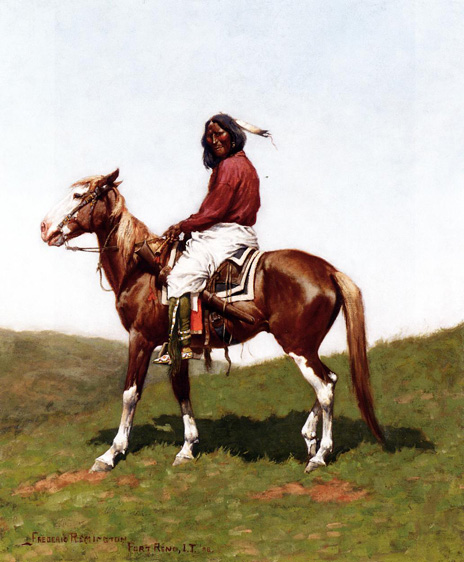

In 1752, there was discovered at San Saba a silver-mine, which drew to the fort quite an increase of population. It is probable that the bad behavior of the miners toward the Indians brought on the terrible massacre of 1758.
At the time of its occurrence, there was a fort, surrounding an acre of ground, under a twelve-feet stone wall, enclosing a church and other buildings.
The story of Presidio San Sabá is a story of Texas. It is a story of contentions and competing interests. It is the story of the Spanish Colonial pursuits of God, glory, and gold, and of the struggle of Native American groups to thwart the foreign invaders.

Reverisco
Today the presidio (Spanish for "fort") lies in ruins, but it is not hard to imagine how it looked at its height in the mid-1700s, when it was home to more than 300 Spanish soldiers and civilians, some of them women and children.
You can picture the soldiers practicing drills in the presidio's open courtyard while herders tended cattle and farmers worked the nearby fields.
, Presidio San Sabá lies just outside the town of Menard, Texas, at the western edge of the Texas Hill Country. The presidio sits amid Menard's Municipal Golf Course, not far from the clear, winding 

The standing stone ruins are evocative, but they are not from the original 1760 stone construction. Instead, they are the remnants of a past project to reconstruct the presidio. In 1936 and 1937, a crew hired by the Texas Centennial Commission and paid for by a grant from the Texas Legislature reconstructed the northwest portion of Presidio San Sabá as a tangible reminder of the past. Becauzse as you know Texas has to keep the past that still remains. These reconstruction efforts, relatively faithful to the design of the original presidio, began to deteriorate not long after their completion. Today they are just a ruin, another crumbling testament to Texas history.
The Natchez are famous in the anthropological literature on Southeastern Indians for their elaborate social and ceremonial system and for their use of platform mounds, both of which are key to their identity as the last example of the mound-building cultures that dominated the Mississippi Valley during late prehistoric times.Below Medina River Valley
Presidio San Sabá, originally known as Presidio San Luis de las Amarillas, was constructed in April of 1757 by a Spanish force led by Captain Don Diego Ortiz Parilla. The presidio, which was subsidized by the Spanish crown, had a threefold purpose: to protect the nearby Mission Santa Cruz de San Sabá, to assess the validity of rumors of rich silver deposits in the area, and to guard the Spanish frontier against the threat of Indian encroachment.
The companion Mission Santa Cruz de San Sabá was built a few miles downstream for the purpose of Christianizing the Lipan Apache.
But by soliciting the Apache, the Spanish unwittingly made enemies of the Norteños, long-time foes of the Apache.
The Indian groups the Spanish called Norteños ("northerners") included various bands of the Comanche, Wichita, Kitsai, and Caddo tribes who were united in their hatred of the Apache. below reamsa from my collection and on sale
The Nortenos were also trading partners and sometimes competitors whose territories covered a huge swath of the Southern Plains and into the forests of East Texas. In March of 1758 a large force of Nortenos attacked, looted, and burned Mission San Sabá, less than one year after its founding
The mission was never rebuilt, however, the presidio lived on for another 14 years until hope for silver riches waned. The presidio was abandoned in 1772 by order of the Viceroy of New Spain.
Although the location of the mission was "lost" for a number of years, the presidio site has always been obvious.
THE council of the Indies, being duly advised of the irruption of the French, their retreat, and the subsequent measures of De Aguayo to settle the country, induced the king of Spain to issue a royal order in May, 1721, directing the authorities in Texas not to commit further hostilities against the French, but forthwith to fortify all the important places, especially the bay of St. Bernard

(above Monclova)
Accordingly, a military post and mission were established at the crossing of the Neches; and another garrison, called our Lady of Loreto, was located on the bay of St. Bernard, at the place formerly occupied by La Salle. The mission of La Bahia, under the protection of this garrison, was established on the San Antonio, some thirty leagues distant.
The mission of La Bahia, under the protection of this garrison, was established on the San Antonio, some thirty leagues distant. 
 The mission of La Bahia, under the protection of this garrison, was established on the San Antonio, some thirty leagues distant.
The mission of La Bahia, under the protection of this garrison, was established on the San Antonio, some thirty leagues distant. 
The marquis added yet other improvements; three of the missions, that had been driven by the French to San Antonio, were located permanently on that river, which, added to the one already there, made five missions under the protection of the garrison at Bexar.
Artifacts from the site are typical of the Spanish Colonial period in Texas: musket balls, gunflints, horse equipment, hand-forged iron nails, and sherds of imported ceramic olive jars, plates, and bowls.

The marquis de Aguayo, before he returned to his official residence at Monclova, recommended the introduction of colonists, being well satisfied that the country could never be per manently occupied by missionaries and soldiers alone.
St. Denis was still at Natchitoches, enjoying the unbounded confidence of the Indians, familiar with their language, furnishing them with arms, and disposed, at any favorable time, to light the torch of war.
There were other considerations operating on the Spanish. The expenses of the garrisons alone were heavy, costing the royal treasury not less than sixty-three thousand dollars per annum; while the troops were not generally composed of Spaniards, but of the inferior classes of natives, having idle, disorderly, and turbulent habits.
It was therefore better to introduce colonists, who would feel that Texas was their home, and have a lively interest in its improvement and defense, and a like interest in preserving peace with the Indian tribes.

De Aguayo departed for his home in May, 1722. He left in Texas (or, as it was then called, the New Philippines) four garrisons for its defense; that is, at the Adaes mission, one hundred men; at the Neches, or Mound prairie,  twenty-five; at the bay of St. Bernard, ninety; and at San Antonio, fifty-three, making in all two hundred and sixty-eight soldiers.
twenty-five; at the bay of St. Bernard, ninety; and at San Antonio, fifty-three, making in all two hundred and sixty-eight soldiers.
 twenty-five; at the bay of St. Bernard, ninety; and at San Antonio, fifty-three, making in all two hundred and sixty-eight soldiers.
twenty-five; at the bay of St. Bernard, ninety; and at San Antonio, fifty-three, making in all two hundred and sixty-eight soldiers.A brief notice of these troops may be appropriately given. Each soldier received four hundred dollars per annum, out of which he had to pay for his clothing and provisions. What he purchased was furnished by contract, at stipulated prices, and transported on mules from Mexico. 

These prices were necessarily, high. The greater part of the soldiers spent the remainder of their pay in gaming ; they then contracted debts, sold their horses and arms, and became servants to the officers —caring nothing for the dignity of their station, or the public service. They were always ready for a quarrel with the Indians, giving the missionaries more trouble than the savages themselves; and it was not without reason that the enterprising De Aguayo declared that, if colonists could be substituted for soldiers, the friars would be enabled to gain the affections of the Indians.
No sooner, however, had De Aguayo departed, than a trade again sprang up between the French and the Spaniards. The friends and relatives of St. Denis favored it. He was still at Natchitoches(above); his popularity with the Indians was unbounded, and his ability to raise at any time, among the Texan tribes, many thousand warriors, operated powerfully upon the fears of the Spanish garrison at Adaes. 
This trade was greatly favored by the removal of the capital of Louisiana from Mobile to New Orleans. The introduction of horses, mules, and cattle, from the Spanish possessions into those of the French, in exchange for the goods of the Company of the Indies, was carried on with little or no interruption.
The Spanish authorities were jealous, and bound by the orders of their government to prevent this trade and these intrusions of the French; but the captain-general of the province resided at Monclova, many leagues from the French frontier, and the local officers were not more virtuous in those days than at present.
In 1726, however, a war broke out between Spain and England, in which France took part with Spain. This produced a friendly disposition on the frontier; and while Perier, governor of Louisiana, was giving indirect aid and comfort to Spain, in stirring up the Choctaws against the English, Captain St. Denis, at Natchitoches, was increasing the contraband trade with the people
Étienne Périer was the fifth governor of the Louisiana colony. He became governor in 1727. His governorship was marked by the arrival of the first Ursuline nuns in New Orleans in 1727 to establish the first convent within the limits of what was to become the United States as well as a war against the Natchez Indians due to bad relations with Chepart, the commander at Fort Rosalie. 

After agitating the Indians by demanding that they give up either their village or their land, the Indians launched an attack on November 26, 1729 and killed nearly three hundred persons at Fort Rosalie.  The French retaliated and by 1731 had killed or captured most of the Indians. The captured Indians were sent as slaves to Santo Domingo, and the few remaining free moved further westward and joined the Chickasaw Indians. This marked the end of the Natchez Indian Nation. In the same year, the Co
The French retaliated and by 1731 had killed or captured most of the Indians. The captured Indians were sent as slaves to Santo Domingo, and the few remaining free moved further westward and joined the Chickasaw Indians. This marked the end of the Natchez Indian Nation. In the same year, the Co mpany of the Indies petitioned the King of Franceto take back their charter, thus ending their control of the colony. Périer remained governor for two years after Louisiana was returned to the king but became frustrated with deteiorating relations with the Chickasaws and lost interest in the colony.
mpany of the Indies petitioned the King of Franceto take back their charter, thus ending their control of the colony. Périer remained governor for two years after Louisiana was returned to the king but became frustrated with deteiorating relations with the Chickasaws and lost interest in the colony. He resigned, and Jean-Baptiste le Moyne de Bienville was chosen to yet again be governor of the colony. of Texas.Natchez Indians were counted among the thousands of warriors who chased the broken Spanish army down the Mississippi River as they sought their escape from North American under the command of Soto's successor, Luis Moscoso de Alvarado.Natchez dwelling
He resigned, and Jean-Baptiste le Moyne de Bienville was chosen to yet again be governor of the colony. of Texas.Natchez Indians were counted among the thousands of warriors who chased the broken Spanish army down the Mississippi River as they sought their escape from North American under the command of Soto's successor, Luis Moscoso de Alvarado.Natchez dwelling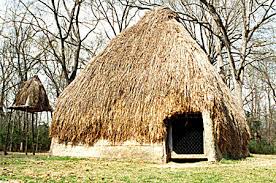
When La Salle descended the Mississippi at the end of the following century, the Natchez occupied a series of towns on the east bank of the river, in the vicinity of the modern town that today bears their name. They controlled a large territory that extended along both sides of the lower Mississippi River. The French retaliated and by 1731 had killed or captured most of the Indians. The captured Indians were sent as slaves to Santo Domingo, and the few remaining free moved further westward and joined the Chickasaw Indians. This marked the end of the Natchez Indian Nation. In the same year, the Co
The French retaliated and by 1731 had killed or captured most of the Indians. The captured Indians were sent as slaves to Santo Domingo, and the few remaining free moved further westward and joined the Chickasaw Indians. This marked the end of the Natchez Indian Nation. In the same year, the Co mpany of the Indies petitioned the King of Franceto take back their charter, thus ending their control of the colony. Périer remained governor for two years after Louisiana was returned to the king but became frustrated with deteiorating relations with the Chickasaws and lost interest in the colony.
mpany of the Indies petitioned the King of Franceto take back their charter, thus ending their control of the colony. Périer remained governor for two years after Louisiana was returned to the king but became frustrated with deteiorating relations with the Chickasaws and lost interest in the colony. He resigned, and Jean-Baptiste le Moyne de Bienville was chosen to yet again be governor of the colony. of Texas.Natchez Indians were counted among the thousands of warriors who chased the broken Spanish army down the Mississippi River as they sought their escape from North American under the command of Soto's successor, Luis Moscoso de Alvarado.Natchez dwelling
He resigned, and Jean-Baptiste le Moyne de Bienville was chosen to yet again be governor of the colony. of Texas.Natchez Indians were counted among the thousands of warriors who chased the broken Spanish army down the Mississippi River as they sought their escape from North American under the command of Soto's successor, Luis Moscoso de Alvarado.Natchez dwellingThe Natchez are famous in the anthropological literature on Southeastern Indians for their elaborate social and ceremonial system and for their use of platform mounds, both of which are key to their identity as the last example of the mound-building cultures that dominated the Mississippi Valley during late prehistoric times.Below Medina River Valley

Medina Valley
At this period, the Medina seemed to be well understood as the western limit of Texas; and, although it was called a separate province, it appears to have been under the control of the governor of Coahuila, or at least both provinces were under the jurisdiction of the same governor. De Aguayo was appointed by the viceroy, in 1719, as governor of both provinces; and so the appointments continued till 1727, when a governor was appointed for each province.![[Reamsa+Caballeria+india.JPG]](https://blogger.googleusercontent.com/img/b/R29vZ2xl/AVvXsEiwbkPiqIGeOeXu9RUGlw2BchEphamVn1vZJNdkRm_iofofUnm3r-4-vKuxeJ1YN_unOeGPS3XqXNrosw6QkQEA8WrvcYxJJzSjzIxva7xuC8_JzjdN4e8oppsNOu98wF3tboQ6rti5Zg/s1600/Reamsa+Caballeria+india.JPG)
At this period, the Medina seemed to be well understood as the western limit of Texas; and, although it was called a separate province, it appears to have been under the control of the governor of Coahuila, or at least both provinces were under the jurisdiction of the same governor. De Aguayo was appointed by the viceroy, in 1719, as governor of both provinces; and so the appointments continued till 1727, when a governor was appointed for each province.
![[Reamsa+Caballeria+india.JPG]](https://blogger.googleusercontent.com/img/b/R29vZ2xl/AVvXsEiwbkPiqIGeOeXu9RUGlw2BchEphamVn1vZJNdkRm_iofofUnm3r-4-vKuxeJ1YN_unOeGPS3XqXNrosw6QkQEA8WrvcYxJJzSjzIxva7xuC8_JzjdN4e8oppsNOu98wF3tboQ6rti5Zg/s1600/Reamsa+Caballeria+india.JPG)
di y dor blog


No comments:
Post a Comment